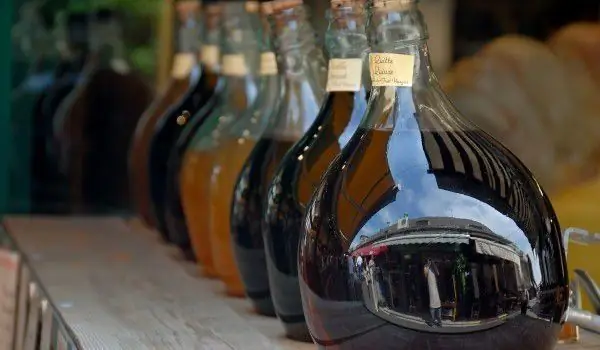2025 Author: Jasmine Walkman | [email protected]. Last modified: 2025-01-23 10:18
In our country, vinegar is our favorite sour liquid for flavoring soups and salads, and in the preparation of various pickles. Behind the constant and unobtrusive presence in the menu lies a long history and a huge variety of flavors, colors and aromas.
The appearance of vinegar is determined by the wine, its actual predecessor. The transformation of wine into vinegar is simple - the molecules of ethyl alcohol are oxidized and thus, joining an oxygen atom, are converted into acetic acid. The process can take place on its own, but through the intervention of acetic acid bacteria and their enzymes it is accelerated many times over.
However, wine is not the only raw material by which we can obtain vinegar. Virtually any liquid containing even a minimal alcohol content is capable of undergoing acetic acid fermentation. Therefore, there are also exotic varieties of vinegar, such as pineapple or banana, produced in some tropical countries.

The variety of vinegar types is determined by the contained vitamins, minerals and numerous and diverse components inherent in the starting product. They determine the different aromatic characteristics of vinegar.
The main types of vinegar are
Wine vinegar
Known to every household, there is no home in which you can not find it. It is produced from mixed white and red table wines, mostly by the method of rapid fermentation.
Balsamic vinegar

This sour vinegar is a symbol of Italian cuisine. In fact, the definition of sour is wrong, as in many cases the sweet taste is predominant. The liquid is dark brown and is a mixture of wine vinegar concentrated by heating grape juice, caramel colorant (E150d) and sulfur dioxide (E220), which prevents spoilage of the product - a method used in many wines.
The best balsamic vinegar, which has been produced for hundreds of years in Modena, Italy, has been aged in special barrels for decades and contains no preservatives or dyes. 1 g of this vinegar costs almost as much as 1 g of gold.
Apple vinegar
The original technology for its production requires alcoholic fermentation of apple juice, followed by acetic acid fermentation. It is widespread, mainly due to its attributed slimming properties. That is why, however, it is often falsified. In rare cases, what appears to be apple cider vinegar is acetic acid dissolved in water with added colorants.

Rice vinegar
Popular mostly in the far east, this liquid is made from rice. In Japan, rice vinegar is colorless or pale yellow and is mixed with sake and sugar. In China, on the other hand, rice vinegar has a dark brown color because it is made from rice with black husks.
Raspberry vinegar
This extremely fragrant liquid is great in marinades for different types of meat. It is prepared by adding small raspberries to 1 liter of apple cider vinegar after boiling.
To diversify the market, many manufacturers add vinegar flavors - fresh and dry spices. Tarragon, for example, is often used for this purpose, as white wine vinegar, reduced along with it, is a mandatory ingredient in one of the classic sauces - Bearnaise sauce.
In the Arab world, vinegar is made from dates, in India - from coconuts and palm wine, and in Northern Europe, vinegar is made from barley malt and beer. Different people - different types of vinegar.
Recommended:
Undisputed Benefits Of Balsamic Vinegar

strong Balsamic vinegar has a high nutritional value, contains a minimum amount of calories and is a natural product. In fact, it is a thick, dark and slightly sweet liquid with an extremely rich taste. It enriches food well and is a powerful antioxidant for the human body.
Apple Cider Vinegar And Its Health Benefits

Apple cider vinegar is preferred by many people around the world due to the fact that it brings a number of health benefits. It is made from apple cider, which undergoes fermentation, resulting in the formation of probiotics and enzymes that stimulate health.
How To Make Wine Vinegar At Home

Wine vinegar is needed to prepare various dishes and salads. The vinegar you prepare at home is more useful and tasty. It is more fragrant and is saturated with more nutrients, and is prepared without the addition of harmful preservatives. Homemade vinegar is used to make different types of pickles.
Preparation Of Apple Cider Vinegar At Home

Homemade apple cider vinegar is a natural product that is easy to prepare and has amazing healing and dietary properties. You can use vinegar as a spice for salads and dishes, as well as a preservative for pickles. Homemade apple cider vinegar can give you health.
Let's Make Rice Vinegar At Home

You need more time than labor to make rice vinegar. You will need rice vinegar if you are preparing Asian dishes. It adds a more specific and rich taste to food. Rice vinegar is made from rice wine, but only fermented rice can be used to make it.

